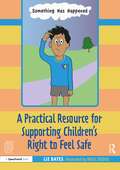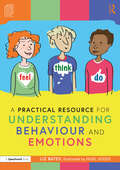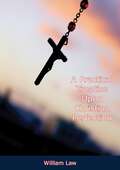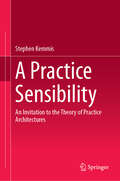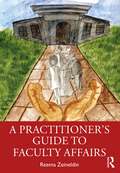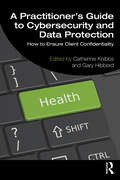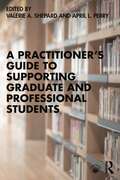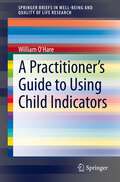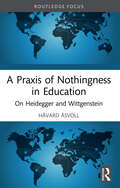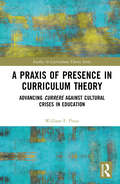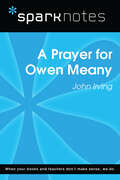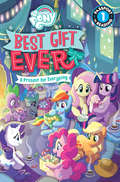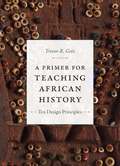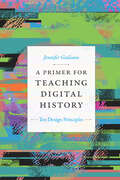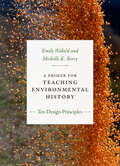- Table View
- List View
A Practical Resource for Supporting Children’s Right to Feel Safe
by Liz BatesFor effective use, this book should be purchased alongside the storybook. Both books can be purchased together as a set, Something Has Happened: A Storybook and Guide for Safeguarding and Supporting Children’s Right to Feel Safe [978-1-032-06912-8] This programme of activities, created to be used alongside the storybook, Something Has Happened, has been designed to help children develop their own internal measure of safety, and teaches them how to ask for help if they feel unsafe. The sessions and activities in this book directly correlate to episodes in the storybook Something Has Happened, covering the fundamental aspects of safeguarding as well as elements of the Protective Behaviours (PB) process. Taking adults and children through a wide range of discussion points and activities, all underpinned by clear guidance, it acts as a starting point to help children understand that being safe from harm is the most important right they have and that the trusted adults around them will always take action to believe and protect them. Key features of this resource include: Session plans that directly link to events in the Something Has Happened storybook Clear, detailed and accessible activity plans that can be used with whole classes, small groups or with individual children Photocopiable activity sheets With a concise and accessible introduction to the right to feel safe and Protective Behaviours, this is an invaluable resource for teachers, support staff and other professionals working with both primary and lower-secondary aged children.
A Practical Resource for Understanding Behaviour and Emotions (Feel, Think Do with Ruby, Rafa and Riz: A Storybook and Guide for Understanding Behaviour and Emotions)
by Liz BatesFor effective use, this book should be purchased alongside the storybook. Both books can be purchased together as a set, Feel, Think and Do with Ruby, Rafa and Riz: A Storybook and Guide for Understanding Behaviour and Emotions, 978-1-032-05939-6.Written as the adult accompaniment to the Feel, Think and Do with Ruby, Rafa and Riz storybook, this resource explores behaviour with strategies for supporting children who struggle to manage their responses and behaviours; and the role of the adult in recognising signs, de-escalation, connection and reflection. Designed to assist adults in introducing children to their inner world and connecting that world to the world around us in an emotionally safe space, this guidebook contains six sessions that can be delivered to children in a large group, as a class, in smaller groups or individually. These sessions provide the context and landscape of the emotional health of children and what can affect their wellbeing, such as: risk factors and protective factors principles – emotional intelligence, emotional regulation emotions and learning creating emotionally safe spaces the imaginary iceberg – our feelings and thoughts are hidden; our behaviour is on show. Full of opportunities for children to talk about and discuss both the events in the story and their own feelings, thoughts, opinions and ideas, this book enables teachers, support staff and all those working directly with children to expertly cover topics such as the hidden nature of feelings and thoughts, the fact that behaviour is the bit on show, and how talking about feelings and thoughts can help to explain and understand behaviour.
A Practical Treatise Upon Christian Perfection
by William LawWilliam Law, born in 1686, became a Fellow of Emmanuel College, Cambridge in 1711, but in 1714, at the death of Queen Anne, he became a non-Juror: that is to say, he found himself unable to take the required oath of allegiance to the Hanoverian dynasty (who had replaced the Stuart dynasty) as the lawful rulers of the United Kingdom, and was accordingly ineligible to serve as a university teacher or parish minister. He became for ten years a private tutor in the family of the historian Edward Gibbon (who, despite his generally cynical attitude toward all things Christian, invariably wrote of Law with respect and admiration), and then retired to his native King's Cliffe. Forbidden the use of the pulpit and the lecture-hall, he preached through his books. These include Christian Perfection, the Spirit of Love, the Spirit of Prayer, and, best-known of all, A Serious Call To a Devout and Holy Life, published in 1728.‘Law was about forty years of age when he wrote it and had he written no more, his reputation as a prose writer and ascetic theologian would have been established. The title of the book also Illustrates two dominant traits in his personality, the concern to be practical and the primary importance of growth in holiness. The perfection he recommends ‘calls no one to a cloyster, but to a right and full performance of those duties, which are necessary for all Christians, and common to all states of life'. It is the heart that finds expression in our actions, and it is the heart, therefore, that must be made perfect.' (A. Keith Walker, William Law, p. 47; quotation from Law's Introduction, p. 2)
A Practice Sensibility: An Invitation to the Theory of Practice Architectures
by Stephen KemmisThis book introduces readers to the theory of practice architectures and conveys a way of approaching practice theory through developing a practice sensibility. It shows that, in order to change our practices, we must also change the conditions that make those practices possible. The book draws on everyday life to illustrate how we can see the world by watching it unfold in practices: it argues that life happens in practices. The theory of practice architectures takes the ontological nature of practices seriously by recognising that practices take place in the real world. Consequently, the book offers a new perspective on how practices happen amidst a vast world of happenings; on how we participate in the “happening-ness” of the world through our practices. It invites us to consider whether our practices reproduce or aggravate the contemporary environmental crises confronting the Earth, and whether we can transform our current practices to ameliorate these crises. Given its focus and scope, the book will benefit master’s and doctoral students in social and educational theory, early career researchers, and established researchers new to practice theory.
A Practitioner's Guide to Faculty Affairs
by Reema ZeineldinThis book aims to define and establish faculty affairs as a discipline within higher education, offering practical recommendations and guidance on how to effectively support academic personnel.Leading with a comprehensive exploration of faculty affairs and its scope, this book responds to existing needs in the field by covering how to appraise the status of faculty affairs within an institution, determine the risks and rewards of creating a faculty affairs unit, chart the planning measures necessary for execution, and more. Worksheets, practical tips, and chapter objectives give readers the opportunity to account for their own unique context and tailor approaches for maximum impact. Carefully selected case studies showcase excellent faculty affairs work across institution types for a wide range of guiding models.This premier guidebook is intended for leaders and staff engaged in the management and administration of faculty affairs.
A Practitioner’s Guide to Cybersecurity and Data Protection: How to Ensure Client Confidentiality
by Catherine Knibbs Gary HibberdA Practitioner’s Guide to Cybersecurity and Data Protection offers an accessible introduction and practical guidance on the crucial topic of cybersecurity for all those working with clients in the fields of psychology, neuropsychology, psychotherapy, and counselling. With expert insights, it provides essential information in an easy-to-understand way to help professionals ensure they are protecting their clients’ data and confidentiality, and protecting themselves and their patients from cyberattacks and information breaches, along with guidance on ethics, data protection, cybersecurity practice, privacy laws, child protection, and the rights and freedoms of the people the practitioners work with. Explaining online law, privacy, and information governance and data protection that goes beyond the GPDR, it covers key topics including: contracts and consent; setting up and managing safe spaces; children's data rights and freedoms; email and web security; and considerations for working with other organisations. Illustrated with examples from peer-reviewed research and practice, and with practical ‘top tips’ to help you implement the advice, this practical guide is a must-read for all working-from-home practitioners in clinical psychology, developmental psychology, neuropsychology, counselling, and hypnotherapy.
A Practitioner’s Guide to Supporting Graduate and Professional Students
by Valerie A. ShepardThis guide helps faculty and student affairs practitioners better serve graduate and professional school students as they navigate what can be an isolating, taxing, and unfamiliar context. Providing actionable strategies, as well as a common language for practitioners to advocate for themselves and for their students, this book is a quick start manual that defines current issues around graduate and professional student development. Drawing together current resources and research around post-baccalaureate student outcomes, this book explores the diverse student needs of graduate and professional students and provides a clear understanding of their social, personal, and psychological development and how to support their success. Case studies showcase specific examples of practice including a holistic development model for graduate training; integrating academic, personal, professional, and career development needs; promising practices for engagement; a diversity, equity, and inclusion approach to access and outcomes; how graduate schools can be important partners to student affairs professionals; and examples of assessment in action. This book provides tools, resources, communication strategies, and actionable theory-to-practice connections for practitioners, professionals, and faculty at all levels who work to support post-baccalaureate student thriving. Appendix available for download online at www.routledge.com/9780367639884 on the tab that is entitled "Support Material."
A Practitioner’s Guide to Using Child Indicators (SpringerBriefs in Well-Being and Quality of Life Research)
by William O'HareThis book focuses on projects using child indicators outside of a research context and provides a user-friendly set of materials to help professionals or organizations start and sustain high-quality child indicator projects. The book is based on the fundamental idea that better data leads to better decisions regarding programs for children. The number of people with experience and expertise in developing child indicator projects is limited in many countries. This initiative provides critical information on the topic in a cost-effective manner, and thereby fills an important niche regarding the use of child indicators. To the extent that it promotes more and better child indicator projects, the book leads to more attention for children and better decision-making regarding public support for children. It is also likely to increase the number of such projects that exist and to improve the quality of such projects. This easy-to-use and practical guide is for all professionals and organizations working with child indicators data.
A Praxis of Nothingness in Education: On Heidegger and Wittgenstein (Routledge International Studies in the Philosophy of Education)
by Håvard ÅsvollThis book puts forward a "theory of Nothing" and shows how a praxis of "Nothing" can offer new possibilities for educational research and practice. Taking inspiration from Heidegger’s and Wittgenstein’s philosophy and with regards to phenomenology and language, the book indicates how nothing can be a condition for an educational technology. The book translates the complex philosophical thinking of Heidegger and Wittgenstein into the realm of education studies, drawing on their perspectives to contribute to an understanding of how nothingness comes into being and how this relates to education. Arguing that nothingness addresses new possibilities for understanding and how we perceive the world and our place in it, the book theorises different aspects that can be included in a theory of Nothing; including indeterminateness, embodiment and how the inexpressible can be made expressible. The book presents vignettes and examples of educational practice and explores how nothing can show up in educational research, theory and practice. Outlining a unique conceptualisation of nothingness in education, the book will be of great interest to academics, researchers and post-graduate students in the field of educational philosophy and educational theory.
A Praxis of Presence in Curriculum Theory: Advancing Currere against Cultural Crises in Education (Studies in Curriculum Theory Series)
by William F. PinarBuilding on his seminal methodological contribution to the field – currere – here William F. Pinar posits a praxis of presence as a unique form of individual engagement against current cultural crises in education. Bringing together a series of updated essays, articles, and new writings to form this comprehensive volume, Pinar first demonstrates how a praxis of presence furthers the study of curriculum as lived experience to overcome self-enclosure, restart lived and historical time, and understand technology through a process of regression, progression, analysis, and synthesis. Pinar then further illustrates how this practice can inform curricular responses to countering presentism, narcissism, and techno-utopianism in educators’ work with "digital natives." Ultimately, this book offers researchers, scholars, and teacher educators in the fields of curriculum theory, the sociology of education, and educational policy more broadly the analytical and methodological tools by which to advance their understanding of currere, and in doing so, allows them to tackle the main cultural issues that educators face today.
A Prayer for Owen Meany (SparkNotes Literature Guide Series)
by SparkNotesA Prayer for Owen Meany (SparkNotes Literature Guide) by John Irving Making the reading experience fun! Created by Harvard students for students everywhere, SparkNotes is a new breed of study guide: smarter, better, faster. Geared to what today's students need to know, SparkNotes provides: *Chapter-by-chapter analysis *Explanations of key themes, motifs, and symbols *A review quiz and essay topicsLively and accessible, these guides are perfect for late-night studying and writing papers
A Present for Everypony: My Little Pony (Passport to Reading Level 1)
by Jennifer FoxAn exciting leveled reader based on the upcoming holiday special My Little Pony: Best Gift Ever!Passport to Reading Level 1 ©2018 Hasbro. All Rights Reserved.
A Primer for Teaching African History: Ten Design Principles (Design Principles for Teaching History)
by Trevor R. GetzA Primer for Teaching African History is a guide for college and high school teachers who are teaching African history for the first time, for experienced teachers who want to reinvigorate their courses, for those who are training future teachers to prepare their own syllabi, and for teachers who want to incorporate African history into their world history courses. Trevor R. Getz offers design principles aimed at facilitating a classroom experience that will help students navigate new knowledge, historical skills, ethical development, and worldviews. He foregrounds the importance of acknowledging and addressing student preconceptions about Africa, challenging chronological approaches to history, exploring identity and geography as ways to access historical African perspectives, and investigating the potential to engage in questions of ethics that studying African history provides. In his discussions of setting goals, pedagogy, assessment, and syllabus design, Getz draws readers into the process of thinking consciously and strategically about designing courses on African history that will challenge students to think critically about Africa and the discipline of history.
A Primer for Teaching Digital History: Ten Design Principles (Design Principles for Teaching History)
by Jennifer GuilianoA Primer for Teaching Digital History is a guide for college and high school teachers who are teaching digital history for the first time or for experienced teachers who want to reinvigorate their pedagogy. It can also serve those who are training future teachers to prepare their own syllabi, as well as teachers who want to incorporate digital history into their history courses. Offering design principles for approaching digital history that represent the possibilities that digital research and scholarship can take, Jennifer Guiliano outlines potential strategies and methods for building syllabi and curricula. Taking readers through the process of selecting data, identifying learning outcomes, and determining which tools students will use in the classroom, Guiliano outlines popular research methods including digital source criticism, text analysis, and visualization. She also discusses digital archives, exhibits, and collections as well as audiovisual and mixed-media narratives such as short documentaries, podcasts, and multimodal storytelling. Throughout, Guiliano illuminates how digital history can enhance understandings of not just what histories are told but how they are told and who has access to them.
A Primer for Teaching Environmental History: Ten Design Principles (Design Principles for Teaching History)
by Emily Wakild Michelle K. BerryA Primer for Teaching Environmental History is a guide for college and high school teachers who are teaching environmental history for the first time, for experienced teachers who want to reinvigorate their courses, for those who are training future teachers to prepare their own syllabi, and for teachers who want to incorporate environmental history into their world history courses. Emily Wakild and Michelle K. Berry offer design principles for creating syllabi that will help students navigate a wide range of topics, from food, environmental justice, and natural resources to animal-human relations, senses of place, and climate change. In their discussions of learning objectives, assessment, project-based learning, using technology, and syllabus design, Wakild and Berry draw readers into the process of strategically designing courses on environmental history that will challenge students to think critically about one of the most urgent topics of study in the twenty-first century.
A Primer for Teaching Indian Ocean World History: Ten Design Principles (Design Principles for Teaching History)
by Edward A. Alpers Thomas F. McDowA Primer for Teaching Indian Ocean World History is a guide for college and high school educators who are teaching Indian Ocean histories for the first time or who want to reinvigorate their courses. It can also serve those who are training future teachers to prepare their own syllabi, as well as those who want to incorporate Indian Ocean histories into their world history courses. Edward A. Alpers and Thomas F. McDow offer course design principles that will help students navigate topics ranging from empire, geography, slavery, and trade to mobility, disease, and the environment. In addition to exploring non-European sources and diverse historical methodologies, they discuss classroom pedagogy and provide curriculum possibilities that will help instructors at any level enrich and deepen standard approaches to world history. Alpers and McDow draw readers into strategically designing courses that will challenge students to think critically about a vast area with which many of them are almost entirely unfamiliar.
A Primer for Teaching Pacific Histories: Ten Design Principles (Design Principles for Teaching History)
by Matt K. MatsudaA Primer for Teaching Pacific Histories is a guide for college and high school teachers who are teaching Pacific histories for the first time or for experienced teachers who want to reinvigorate their courses. It can also serve those who are training future teachers to prepare their own syllabi, as well as teachers who want to incorporate Pacific histories into their world history courses. Matt K. Matsuda offers design principles for creating syllabi that will help students navigate a wide range of topics, from settler colonialism, national liberation, and warfare to tourism, popular culture, and identity. He also discusses practical pedagogical techniques and tips, project-based assignments, digital resources, and how Pacific approaches to teaching history differ from customary Western practices. Placing the Pacific Islands at the center of analysis, Matsuda draws readers into the process of strategically designing courses that will challenge students to think critically about the interconnected histories of East Asia, Southeast Asia, Australia, the Pacific Islands, and the Americas within a global framework.
A Primer for Teaching Women, Gender, and Sexuality in World History: Ten Design Principles (Design Principles for Teaching History)
by Merry E. Wiesner-Hanks Urmi Engineer WilloughbyA Primer for Teaching Women, Gender, and Sexuality in World History is a guide for college and high school teachers who are teaching women, gender, and sexuality in history for the first time, for experienced teachers who want to reinvigorate their courses, for those who are training future teachers to prepare their own syllabi, and for teachers who want to incorporate these issues into their world history classes. Merry E. Wiesner-Hanks and Urmi Engineer Willoughby present possible course topics, themes, concepts, and approaches while offering practical advice on materials and strategies helpful for teaching courses from a global perspective in today's teaching environment for today's students. In their discussions of pedagogy, syllabus organization, fostering students' historical empathy, and connecting students with their community, Wiesner-Hanks and Willoughby draw readers into the process of strategically designing courses that will enable students to analyze gender and sexuality in history, whether their students are new to this process or hold powerful and personal commitments to the issues it raises.
A Primer for Teaching World History: Ten Design Principles
by Antoinette BurtonA Primer for Teaching World History is a guide for college and high school teachers who are designing an introductory-level world history syllabus for the first time, for those who already teach world history and are seeking new ideas or approaches, and for those who train future teachers to prepare any history course with a global or transnational focus. Drawing on her own classroom practices, as well as her career as a historian, Antoinette Burton offers a set of principles to help instructors think about how to design their courses with specific goals in mind, whatever those may be. She encourages teachers to envision the world history syllabus as having an architecture: a fundamental, underlying structure or interpretive focus that runs throughout the course, shaping students' experiences, offering pathways in and out of "the global," and reflecting the teacher's convictions about the world and the work of history.
A Primer in Biological Data Analysis and Visualization Using R
by Gregg HartvigsenR is the most widely used open-source statistical and programming environment for the analysis and visualization of biological data. Drawing on Gregg Hartvigsen's extensive experience teaching biostatistics and modeling biological systems, this text is an engaging, practical, and lab-oriented introduction to R for students in the life sciences.Underscoring the importance of R and RStudio in organizing, computing, and visualizing biological statistics and data, Hartvigsen guides readers through the processes of entering data into R, working with data in R, and using R to visualize data using histograms, boxplots, barplots, scatterplots, and other common graph types. He covers testing data for normality, defining and identifying outliers, and working with non-normal data. Students are introduced to common one- and two-sample tests as well as one- and two-way analysis of variance (ANOVA), correlation, and linear and nonlinear regression analyses. This volume also includes a section on advanced procedures and a chapter introducing algorithms and the art of programming using R.
A Primer in Biological Data Analysis and Visualization Using R
by Gregg HartvigsenR is the most widely used open-source statistical and programming environment for the analysis and visualization of biological data. Drawing on Gregg Hartvigsen’s extensive experience teaching biostatistics and modeling biological systems, this text is an engaging, practical, and lab-oriented introduction to R for students in the life sciences.Underscoring the importance of R and RStudio in organizing, computing, and visualizing biological statistics and data, Hartvigsen guides readers through the processes of correctly entering and analyzing data and using R to visualize data using histograms, boxplots, barplots, scatterplots, and other common graph types. He covers testing data for normality, defining and identifying outliers, and working with non-normally distributed data. Students are introduced to common one- and two-sample tests as well as one- and two-way analysis of variance (ANOVA), correlation, and linear and nonlinear regression analyses. This volume also includes a section on advanced procedures and a chapter outlining algorithms and the art of programming using R.This second edition has been revised to be current with the versions of R software released since the book’s original publication. It features updated terminology, sources, and examples throughout.
A Primer on America's Schools
by Terry M. MoeIn this volume the eleven members of the Koret Task Force on K–12 Education provide a broad overview of the American education system—pulling together basic facts about its structure and operation, identifying key problems that hinder its performance, and offering perspectives on the requirements of genuine reform.
A Primer on Minority Serving Institutions
by Marybeth Gasman Andrés Castro SamayoaMinority Serving Institutions (MSIs)—specifically Historically Black Colleges and Universities (HBCUs), Tribal Colleges and Universities (TCUs), Hispanic-Serving Institutions (HSIs), and Asian American and Native American Pacific Islander-Serving Institutions (AANAPISIs)—have carved out a unique niche in the nation, serving the needs of low-income, underrepresented students of color. Covering foundational topics relating to MSIs, chapter authors explore how salient issues across the landscape of higher education play out within the MSI context. Undergirded by national data and key literature, A Primer on Minority Serving Institutions provides graduate students, scholars, and researchers a full picture of the work and contributions of MSIs and urges them to think about MSIs as part of the larger higher education landscape.
A Primer on Partial Least Squares Structural Equation Modeling (PLS-SEM)
by G. Tomas Hult Marko Sarstedt Christian M. Ringle Joe HairThe third edition of A Primer on Partial Least Squares Structural Equation Modeling (PLS-SEM) guides readers through learning and mastering the techniques of this approach in clear language. Authors Joseph H. Hair, Jr., G. Tomas M. Hult, Christian Ringle, and Marko Sarstedt use their years of conducting and teaching research to communicate the fundamentals of PLS-SEM in straightforward language to explain the details of this method, with limited emphasis on equations and symbols. A running case study on corporate reputation follows the different steps in this technique so readers can better understand the research applications. Learning objectives, review and critical thinking questions, and key terms help readers cement their knowledge. This edition has been thoroughly updated, featuring the latest version of the popular software package SmartPLS 3. New topics have been added throughout the text, including a thoroughly revised and extended chapter on mediation, recent research on the foundations of PLS-SEM, detailed descriptions of research summarizing the advantages as well as limitations of PLS-SEM, and extended coverage of advanced concepts and methods, such as out-of-sample versus in-sample prediction metrics, higher-order constructs, multigroup analysis, necessary condition analysis, and endogeneity.
A Primer on Partial Least Squares Structural Equation Modeling (PLS-SEM)
by G. Tomas Hult Marko Sarstedt Christian M. Ringle Joe HairThe third edition of A Primer on Partial Least Squares Structural Equation Modeling (PLS-SEM) guides readers through learning and mastering the techniques of this approach in clear language. Authors Joseph H. Hair, Jr., G. Tomas M. Hult, Christian Ringle, and Marko Sarstedt use their years of conducting and teaching research to communicate the fundamentals of PLS-SEM in straightforward language to explain the details of this method, with limited emphasis on equations and symbols. A running case study on corporate reputation follows the different steps in this technique so readers can better understand the research applications. Learning objectives, review and critical thinking questions, and key terms help readers cement their knowledge. This edition has been thoroughly updated, featuring the latest version of the popular software package SmartPLS 3. New topics have been added throughout the text, including a thoroughly revised and extended chapter on mediation, recent research on the foundations of PLS-SEM, detailed descriptions of research summarizing the advantages as well as limitations of PLS-SEM, and extended coverage of advanced concepts and methods, such as out-of-sample versus in-sample prediction metrics, higher-order constructs, multigroup analysis, necessary condition analysis, and endogeneity.
